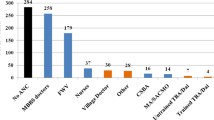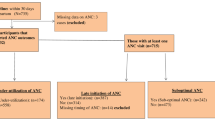Abstract
To evaluate the effectiveness of decentralizing ambulatory reproductive and intrapartum services to increase rates of antenatal care (ANC) utilization and skilled attendance at birth (SAB) in Rwanda. A prospective cohort study was implemented with one control and two intervention sites: decentralized ambulatory reproductive healthcare and decentralized intrapartum care. Multivariate logistic regression analysis was performed with primary outcome of lack of SAB and secondary outcome of ≥3 ANC visits. 536 women were entered in the study. Distance lived from delivery site significantly predicted SAB (p = 0.007), however distance lived to ANC site did not predict ≥3 ANC visits (p = 0.81). Neither decentralization of ambulatory reproductive healthcare (p = 0.10) nor intrapartum care (p = 0.40) was significantly associated with SAB. The control site had the greatest percentage of women receive ≥3 ANC visits (p < 0.001). Receiving <3 ANC visits was associated with a 3.98 times greater odds of not having SAB (p = 0.001). No increase in adverse outcomes was found with decentralization of ambulatory reproductive health care or intrapartum care. The factors that predict utilization of physically accessible services in rural Africa are complex. Decentralization of services may be one strategy to increase rates of SAB and ANC utilization, but selection biases may have precluded accurate analysis. Efforts to increase ANC utilization may be a worthwhile investment to increase SAB.
Similar content being viewed by others
References
World Health Organization. Trends in Maternal Mortality: 1990–2013. WHO, UNICEF, UNFPA, and The World Bank Estimates. http://www.who.int/reproductivehealth/publications/monitoring/maternal-mortality-2013/en/. Published 2014. Accessed July 24, 2014.
Campbell, O., & Graham, W. (2006). Strategies for reducing maternal mortality: Getting on with what works. Lancet, 368(9543), 1284–1299.
World Health Organization. Making pregnancy safer: The critical role of the skilled attendant. A joint statement by WHO, ICM and FIGO. http://whqlibdoc.who.int/publications/2004/9241591692.pdf. Published 2004. Accessed August 17, 2013.
World Health Organization. Reduction of maternal mortality. A joint WHO/UNFPA/UNICEF/World Bank statement. http://www.unfpa.org/upload/lib_pub_file/236_filename_e_rmm.pdf. Published 1999. Accessed August 29, 2013.
Ensor, T., & Ronoh, J. (2005). Impact of organizational change on the delivery of reproductive services: A review of the literature. The International Journal of Health Planning and Management, 20(3), 209–225.
United Nations Children’s Fund. Decentralization: Equity and sectoral policy implications for UNICEF in East Asia and the Pacific. http://www.unicef.org/eapro/1_Decentralization_and_Equity_Working.pdf. Published 2011. Accessed July 27, 2013.
Fitzgerald, D., Behets, F., Preval, J., Shulwolf, L., Bommi, V., & Chaillet, P. (2003). Decreased congenital syphilis incidence in Haiti’s rural artibonite region following decentralized antenatal screening. American Journal of Public Health, 93(3), 444–446.
Berardi, J. C., Richard, A., Djanhan, Y., & Papiernik, E. (1989). Evaluation of the benefit of setting up a decentralised obstetric-surgical structure in order to reduce maternal mortality and transfers in the Ivory Coast. International Journal of Gynaecology and Obstetrics, 29(1), 13–17.
Gabrysch, S., Cousens, S., Cox, J., & Campbell, O. M. (2011). The influence of distance and level of care on delivery place in rural Zambia: A study of linked national data in a geographic information system. PLoS Medicine, 8(1), e1000394.
Simkhada, B., Tejilingen, E. R., Porter, M., & Simkhada, P. (2008). Factors affecting the utilization of antenatal care in developing countries: Systematic review of the literature. Journal of Advanced Nursing, 61(3), 244–260.
National Institute of Statistics of Rwanda. Rwanda Demographic and Health Survey 2010. http://www.measuredhs.com/pubs/pdf/FR259/FR259.pdf. Published 2012. Accessed July 30, 2013.
Magadi, M., Diamond, I., & Rodrigues, R. N. (2000). Determinants of delivery care in Kenya. Social Biology, 47(3–4), 164–188.
Yanaagisawa, S., Oum, S., & Wakai, S. (2006). Determinants of skilled birth attendance in rural Cambodia. Tropical Medicine & International Health, 11(2), 238–251.
Kowalewski, M., Jahn, A., & Kimatta, S. S. (2000). Why do at-risk mother fail to reach referral level? Barriers beyond distance and cost. African Journal of Reproductive Health, 4(1), 100–109.
Mrisho, M., Obrist, B., Schellenberg, J. A., Haws, R. A., Mushi, A. K., Mshinda, H., et al. (2009). The use of antenatal and postnatal care: Perspectives and experiences of women and health care providers in rural southern Tanzania. BMC Pregnancy Childbirth, 9, 10.
Acknowledgments
The project described was supported by the National Center for Advancing Translational Sciences (NCATS), a component of the National Institutes of Health (NIH), through CTSA grant numbers UL1TR000086, TL1RR000087, and KL2TR000088. Its contents are solely the responsibility of the authors and do not necessarily represent the official views of the NIH.
Conflict of interest
No authors have conflicts of interest to disclose.
Author information
Authors and Affiliations
Corresponding author
Rights and permissions
About this article
Cite this article
Nathan, L.M., Shi, Q., Plewniak, K. et al. Decentralizing Maternity Services to Increase Skilled Attendance at Birth and Antenatal Care Utilization in Rural Rwanda: A Prospective Cohort Study. Matern Child Health J 19, 1949–1955 (2015). https://doi.org/10.1007/s10995-015-1702-5
Published:
Issue Date:
DOI: https://doi.org/10.1007/s10995-015-1702-5




